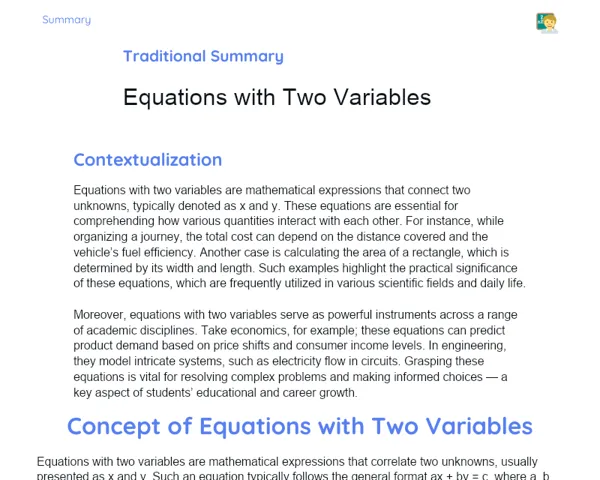Objectives
1. 🚀 Get comfortable with logarithms to tackle equations of varying levels of difficulty.
2. 🧠 Use logarithmic concepts in everyday scenarios, from straightforward calculations to complex models in fields like science and engineering.
3. 🤝 Enhance teamwork and critical thinking abilities while addressing real-world challenges and dealing with data in groups.
Contextualization
Did you know that logarithms are not merely a mathematical concept but a vital tool for interpreting events in nature and technology? For instance, logarithms play a key role in measuring earthquake intensity (Richter Scale) and in understanding radioactive decay. By simplifying complicated multiplications into straightforward additions, logarithms serve as an essential tool across various domains, from biology to software development.
Important Topics
Properties of Logarithms
Logarithms come with essential properties that help solve complex equations, and getting a grip on these is critical for applying logarithms to real-life scenarios. These properties include the product property, quotient property, and power property, which convert multiplication, division, and exponentiation into addition, subtraction, and easier multiplication respectively.
-
Product Property: log_b(xy) = log_b(x) + log_b(y). This property helps break down logarithms of products into sums of logarithms, making it easier to solve equations.
-
Quotient Property: log_b(x/y) = log_b(x) - log_b(y). This helps change the logarithm of a division into a difference, aiding in calculations that involve rates of change.
-
Power Property: log_b(x^y) = y*log_b(x). This allows for manipulation of powers within logarithms, which is crucial for solving equations related to exponential growth or decay.
Basic Logarithmic Equations and Their Applications
Learning how to manipulate and solve basic logarithmic equations is a stepping stone to applying logarithms in wider contexts such as science and engineering. These equations, derived from the properties of logarithms, can help find unknown values in real-life situations.
-
Basic Form: log_b(x) = y transforms to b^y = x. This format assists in finding the value of x when b and y are known, which is useful for calculations of decay and exponential growth.
-
Applications in pH and Acoustics: Logarithms are used to calculate pH (the logarithm of H+ ion concentration) or sound intensity in decibels (the logarithm of relative intensity).
-
Temporal Inversion Problems: Solving logarithmic equations can help ascertain timing in processes that exhibit exponential patterns, like radioactivity and compound interest.
Mathematical Modeling with Logarithms
The ability to model real-world situations using logarithms is a valuable skill that enables predictions about behaviors and adjustments in industrial, environmental, and technological processes. Modeling involves developing equations that depict the exponential nature of natural and human activities.
-
Population Growth: Logarithms can be used to model population growth and predict when resources may become limited.
-
Radioactive Decay: Logarithmic equations can estimate the half-life of radioactive materials, which is essential for safety considerations and in nuclear medicine.
-
Process Optimization: Utilizing logarithms to fine-tune parameters in algorithms and control systems, enhancing efficiency and responsiveness.
Key Terms
-
Logarithm: A logarithm is the inverse of exponentiation, representing the exponent to which a given base must be raised to yield a number. This concept emerged in the 17th century to ease complex calculations in fields like astronomy and navigation.
-
Logarithmic Base: The base of the logarithm refers to the number raised to the exponent. The most commonly used bases are 10 (common logarithm) and e (natural logarithm).
-
Logarithmic Equation: An equation that includes logarithms, solved by determining the values that satisfy the logarithmic equality presented.
For Reflection
-
How might the product property of logarithms aid in breaking down the calculations for compound interest in finance?
-
In what ways can understanding logarithms be essential in forecasting natural occurrences such as earthquakes and tsunamis?
-
What effects do advancements in technology have on the practical use of logarithms in emerging fields like artificial intelligence?
Important Conclusions
-
Today, we've delved into the intriguing world of logarithmic equations, showcasing a powerful tool that extends beyond just mathematics and finds application in numerous fields like biology, chemistry, and technology.
-
We grasped the vital properties of logarithms, such as product, quotient, and power properties, which not only simplify intricate calculations but also pave the way for effectively tackling real-world problems.
-
We explored the practical uses of logarithms, from calculating pH in chemistry to modeling growth patterns in biology, emphasizing the significance of these concepts in our everyday lives.
-
The skills to manipulate and apply logarithmic equations to practical problems were strengthened through interactive activities, equipping you to leverage this knowledge in real-life scenarios and across other subjects.
To Exercise Knowledge
To reinforce what we learned today, try these activities at home: Logarithmic Calculator: Utilize an online scientific calculator to solve various logarithmic equations and compare your solutions with manual calculations. pH Diary: Pick common household items like lemon juice or baking soda and estimate their pH levels using logarithms. Population Modeling: Create a model for the population growth of a species using logarithmic functions in a spreadsheet, tweaking different growth rates.
Challenge
Logarithmic Treasure Hunt Challenge: Design a 'treasure map' where the clues are solved through logarithmic equations. Each clue should guide to the next, culminating in the discovery of a 'treasure'. Share your maps and solutions with the class!
Study Tips
-
Make visual summaries of the properties of logarithms and display them in your study area for ongoing review.
-
Practice with math apps that offer logarithmic problems to solve, facilitating an interactive understanding of the concept.
-
Watch educational videos that demonstrate the real-life applications of logarithms, such as in computing or environmental science, to visualize the math in action.


